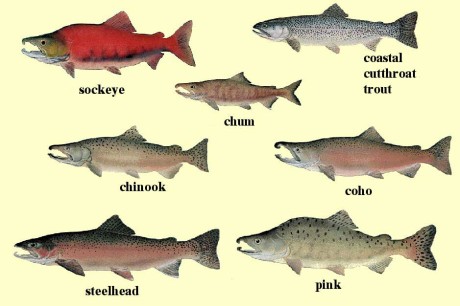Salmon Recovery
Posted January 22, 2013 at 5:52 am by Tim Dustrude
OLYMPIA – The Washington State Salmon Recovery Funding Board today released the 2012 biennial State of the Salmon in Watersheds report and with it launched a new, interactive Web site that allows people to see how salmon are doing in their community’s streams and rivers.
“This is an exciting new approach to our reporting on salmon recovery,” said Kaleen Cottingham, director of the Recreation and Conservation Office, home of the Governor’s Salmon Recovery Office, which created the report and Web site. “For the first time, you can sit at your computer at home and learn about whether the number of salmon are increasing or decreasing in your county, if the rivers and streams in your area are too polluted or too warm for salmon, and what’s being done to make things better. It’s the first Web site in Washington that allows people to see how the state’s investment in salmon recovery is working.”
The Web site puts online what previously was available as a printed biennial report to the Legislature, called the State of Salmon in Watersheds, and provides more extensive maps and data, pulled from many state and local organizations.
“Washington State has been investing in salmon recovery for more than a decade, and we are starting to see some positive effects,” Cottingham said. “In some areas of the state salmon populations are increasing. But we still have a long way to go until all listed species of salmon are recovered enough to be removed from the federal Endangered Species Act list. It took us generations to decimate our salmon and it will take equally long to recover them. Fortunately, Washington is in a good position to do the hard work necessary.”
Salmon need lots of cool, clean water to survive, as well as healthy habitat where they rest, feed, hide from predators, and spawn. The State of Salmon in Watersheds report measures Washington’s progress in those areas. Some findings from the new, online report:
- Measurements of the amount of water in streams and rivers show increasing trends or no trends at 57 percent of monitoring stations in western Washington, and at 45 percent of the monitoring stations in eastern Washington.
- The quality of Washington’s waters, by some measures important to salmon, has improved slightly since 1992. The water quality at 35 percent of long-term water quality monitoring sites is improving, while only 5 percent saw declines. However, other measures of water quality, such as toxins, have not improved.
- Communities continue to make progress implementing actions in recovery plans to restore and protect priority habitat, improve hatcheries, and make dams more fish friendly.
- 61 percent of the Washington Department of Fish and Wildlife’s hatchery programs are meeting or expected to meet scientific standards for proper management to ensure conservation of wild salmon and steelhead.
- Washington has been managing fishing to ensure that salmon and steelhead species at risk of extinction are not over harvested. In the past ten years, Endangered Species Act limits to the amount of fish that can be caught have been met 90 percent of the time, for all but one population.
- During the past 13 years, more than 5,000 fish passage barriers have been replaced with fish-friendly culverts and bridges in Washington streams. This work has opened more than 4,800 miles of fish-spawning habitat statewide. Strong partnerships among regional recovery organizations and state agencies continue to open an average of 360 miles of habitat a year.
“One thing we have learned is that what is good for salmon is also good for communities,” Cottingham said.
Recent Oregon studies showed that every $1 million spent on watershed restoration results in 15-33 new or sustained jobs, $2.2 million to $2.5 million in total economic activity, and that 80 percent of grant money is spent in the county where the project was located. Using the Oregon formula, salmon recovery funding is expected to have supported more than 4,400 new or sustained jobs and more than $640 million in total economic activity in Washington.
“This report makes it clear that we have accomplished much but still have a long way to go,” Cottingham said. “Climate change, development to accommodate the state’s growing population, and decreasing funding, are the most serious threats for salmon recovery in the future. It’s up to all of us to ensure that we have enough funding, enough people, and enough resources to continue this work. It’s so important if we are to ensure the iconic salmon survive.”
See the full report and Web site at www.StateofSalmon.wa.gov.
You can support the San Juan Update by doing business with our loyal advertisers, and by making a one-time contribution or a recurring donation.
Categories: Around Here











No comments yet. Be the first!
By submitting a comment you grant the San Juan Update a perpetual license to reproduce your words and name/web site in attribution. Inappropriate, irrelevant and contentious comments may not be published at an admin's discretion. Your email is used for verification purposes only, it will never be shared.